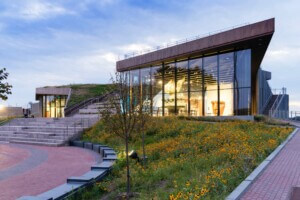Frank Gehry‘s Walt Disney Concert Hall in Los Angeles, Scott Johnson‘s Museum Tower in Dallas, and Rafael Viñoly‘s Vrada Hotel & Spa in Las Vegas have at least one thing in common. All three provoked the ire of their neighbors when glare from their reflective facades raised sidewalk temperatures, blinded drivers, or—as in the Museum Tower case—jeopardized the nearby Nasher Sculpture Center’s collections. Glare is increasingly a problem in facade design, says Curtainwall Design Consulting president Charles Clift, in part because of the tools contemporary architects have at their disposal. “The conclusion I came to is that the digital age of architecture has allowed designers to create anything they can imagine, but with that comes some unintended consequences.”
Clift and other experts in high-performance envelope design, including George Loisos (Loisos + Ubbelohde) and Luke Smith (Enclos), will dig into the problem of glare in a symposium panel at this month’s Facades+ Dallas conference. Nasher Sculpture Center director Jeremy Strick, David Cossum of the City of Dallas, and the Dallas Morning News’ Mark Lamster will join them to discuss the reflectivity challenge within the local context. The conversation will continue on day 2 of the conference at the “Curating Daylight: Effective Control of Interior Illumination & Issues of Exterior Reflectivity” dialog workshop (led by George Loisos and Susan Ubbelohde), which meets at the Nasher Sculpture Center.
Advancements in building materials offer one solution to the glare challenge, which exists in tension with the demand to reduce thermal gain. “An easy way for the facade to accomplish sustainability goals is to use highly reflective glass, but obviously that rejected glare goes back into the environment,” said Clift. Happily, innovations by today’s glass manufacturers, including low-e coatings, boost performance, reduce glare, and allow a decent amount of visible light transmission. External or internal sunshades can also do double duty as thermal barriers and glare blockers. But both specialty glass and shading structures come at a cost, and are often the first to go when the budget gets tight. “A lot of the time, the issue of glare has been taken into account in the design process, but it’s one of the first components that might get value-engineered out,” said Smith, who will moderate the panel.
Municipal-level regulation is another possible fix for the reflectivity problem. Clift reports that some Dallas builders he’s talked to are confident that the market will sort things out. They say that the Museum Tower/Nasher Sculpture Center debacle “is such a bad situation that a savvy developer won’t do that in the future.” Smith is not so sure. “This is an urban problem, but as soon as the city tries to step in, people say, ‘No, this has nothing to do with the city,'” he said. “I think the problem is getting worse because density is increasing in cities, and right now glass is predominantly the building material of choice.” Dallas, he notes, is the perfect place to explore the glare issue. “The city’s going through a regeneration: the place is coming back. Plus, it’s sunny, and they like glass buildings.”
To hear more from Smith, Cliff, and the other panelists about the problem of glare, register today for the Dallas Facades+ conference. The complete lineup of symposium speakers, dialog workshops, tech workshops, and networking events can be found on the conference website.










